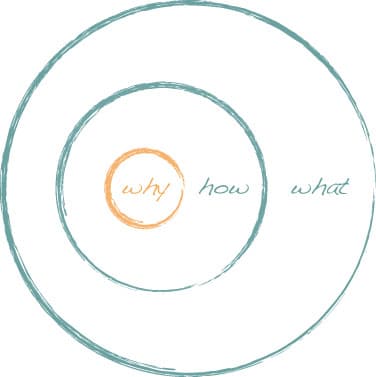Simon Sinek posits that successful companies know “why” they exist, outside of “what” they do for customers, and “how” they do it. His TED talk seems to be everywhere recently. I’ve seen it on Detroit Venture Partner’s website, heard it in John Hwang’s presentation at BarCampGR, and saw it used in as a part of the Momentum program last summer. Melissa Bugai first brought Simon’s idea to my attention early in 2010.
I think having a strong, shared, “why” is a good indicator of a company’s potential for success. It’s one component of culture, the third and critical ingredient necessary to create a sustainable company. Your “why” is different from your “what” and “how”. Apple exists to challenge the status quo and simplify our lives — that’s both easy to understand and explain. Disney believes in good clean family fun — everyone in the world can appreciate it. Facebook helps people share things with their friends. These statements say nothing about “what” these successful companies do or “how” they do it.
I believe innovation services firms have a more difficult job identifying their “why” for two reasons. First, they focus on their craft (“how”), not an end product. Second, they are one step removed from the end users of the products they help create (“what”).
Craft
If you work for an innovation services firm, you presumably care a great deal about how you do what you do. In fact, you care more about the “what” and “how” than you do for any single given application of your talents. You value tools, process, practices and expertise for what they can create, more than you value any one particular product you build. If you’re drawn to the “how” and “what” of your work, then obviously it’s going to be harder to avoid talking from those perspectives when articulating your “why.”
Consider Atomic Object. Our developers are passionate about, among other things, finding better ways of testing software (the “how”) in order to deliver better software to their customers (the “what”). It’s not that we don’t care about the web app we’re working on, or our client’s mobile strategy, it’s just that we’re not in the same business as our clients. If our “why” was to improve the wellness of people in residential care facilities, measure color more accurately than anyone else in the world, or make cars safer through lane departure warning systems (to describe some recent Atomic clients) then presumably we would have gone into one of those businesses. Instead, we’ve chosen to be in the business of using our software design and development talents and skills to help our clients innovate. We’re in this line of work for “what” we do and “how” we do it.
End users
The second challenge of describing the “why” of an innovation services firm is the fact that the end users of our products are not our actual customers. In these cases, it is really important for our clients to have a strong sense of their own “why.” I’ve noticed Atomic makers have a more difficult time working with clients who don’t know their own “why.” This challenge highlights the inherently symbiotic relationship innovation services firms have with their clients. We derive energy and drive to do our best work for people who know why they do what they do and why they’re engaging us to help them innovate. On the flip side, working with people who don’t care about or know why they work for their employer, can be challenging, de-energizing and a little scary. Who’s steering the ship? Can this product succeed? Will it matter? Since their business is not ours, and their “why” is not ours, it is essential for our client to carry that water.
Using your Why
Our strong “why” has always helped us recruit the right people. We look for curiosity, evidence of intolerance for the status quo, a passion for craft, a willingness to experiment, a commitment to customers and professional development, a diversity of tools and experience. The people we want to hire ask us questions that demonstrate they share our “why.” Filtering with our “why” in recruiting serves an internal need.
Our strong “why” is useful in marketing as well. Client prospects seem to consider whether our website is attractive and easy to navigate, what prior work we’ve done, who they might work with (our people), what our culture is like, where we are located, and whether they could form a partnership with us. Notably absent in this list is how we do things (process and practices). While no one identified as being specifically interested in our “why”, I believe many of the criteria we are vetted against are, in fact, determined by this aspect of our company.
Our strong “why” helps us decide on how we might expand our service offering. For example, some of our clients ask us for help with marketing, and many of our projects have marketing needs associated with them. Thinking purely entrepreneurially, this appears like an interesting opportunity. But since it’s not consistent with our “why”, the potential new business is easy to dismiss.
- Attention: Spending Your Most Valuable Currency - February 10, 2022
- Slicing the Revenue Pie in a Multi-Stakeholder Company - July 30, 2021
- Commercial versus Existential Purpose - July 19, 2021
- How I Misunderstood Mentorship and Benefited Anyway - June 16, 2021
- Sabbath Sundays and Slow Mondays - June 4, 2021
